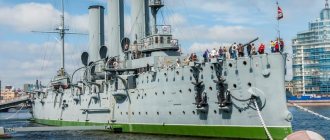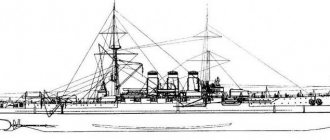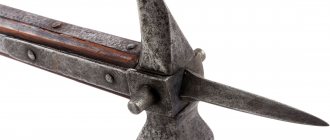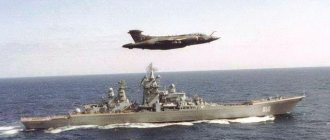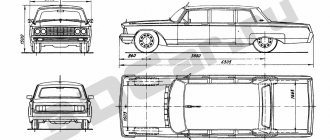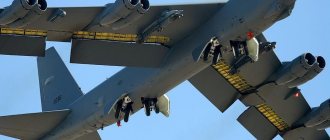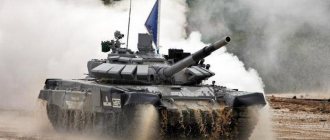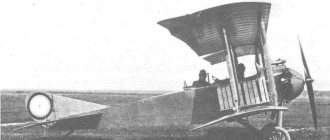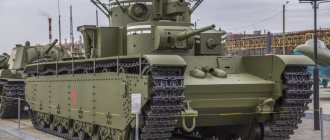Main characteristics
Now we will tell you about the main characteristics of the cruiser “Pallada”, so that even a person unfamiliar with the basics of shipbuilding can appreciate it.
The displacement was 7800 tons - quite decent for its time. For comparison, the much more famous cruiser Varyag had a displacement of only 6,500 tons.
At the same time, the total length of the hull was 137 meters, and the width was 17.5 meters! The draft was also very impressive - more than six meters, which ensured high stability and the ability to go to sea even during the most severe storm.
Two powerful propellers made it possible to reach speeds of up to 21 knots - almost 39 kilometers per hour. And the cruising range was impressive - without refueling, the Pallada could travel 3,900 nautical miles - more than seven thousand kilometers.
The crew consisted of 23 officers, as well as 550 lower ranks - midshipmen, sailors and others.
Design[edit]
Armament of the cruiser "Aurora".
Pallada class cruisers
had a displacement of 6,731 tons (standard) or 6,932 tons (maximum), a length of 126 meters (413 ft), a beam of 16.8 meters (55 ft) and a draft of 6.4 meters (21 ft). Powered by three triple expansion steam engines with a total output of 13,000 horsepower (9,700 kW), they achieved a speed of 19 knots (35 km/h; 22 mph). The ships had a range of 3,700 nautical miles (6,900 km; 4,300 mi) with a coal reserve of 972 tons and a cruising speed of 10 knots (19 km/h; 12 mph). The deck armor was 50–62 mm (2.0–2.4 in) and the command post armor was 150 mm (5.9 in). The crew numbered 578 people.
Pallada class cruisers
were armed with eight 152 mm 45 caliber Model 1892 guns, which were among the best Russian guns of the time. These and twenty-four 75 mm cannons as secondary armament were Russian variants of the French Schneider et Cie Canet cannons. The ships were also equipped with eight 37 mm Hotchkiss guns and three 380 mm torpedo tubes, as well as two Baranovsky 63.5 mm-L/19 landing guns.
Vessel's armament
Many experts already at the beginning of the twentieth century predicted the inevitability of a major war that would affect all European countries, including Russia. Therefore, the cruiser "Pallada" received quite powerful weapons.
Of course, first of all, these are two 203 mm cannons - a few successful hits from such guns were quite enough to send even the largest ship to the bottom.
In addition, eight smaller guns were in service - 152 millimeters each. 22 75-mm guns were intended to work on smaller targets. Finally, in case it would be necessary to defend against aircraft or destroy enemy personnel, eight machine guns were installed on the ship.
But that's not all. Although torpedoes were a novelty in early twentieth-century warfare, and some experts seriously underestimated their power and danger, the Pallada received two 457-millimeter torpedo tubes. Even one good salvo was enough to destroy a large enemy ship.
Two cruisers of the same name
Quite often, when talking about the cruiser Pallada comes up, a serious dispute arises between novice experts. Some argue that it was built at the end of the nineteenth century and was destroyed during the Russo-Japanese War. And others believe that the Pallada was built and launched after the end of this war. Which one is right?
In reality, neither side is wrong. The fact is that such a cruiser was actually built in 1899. It belonged to the class of First Rank armored cruisers. It received its name in honor of the ancient Greek goddess of wisdom - Pallas Athena. Alas, he served the Fatherland for only a short time and already in February 1904 he was sunk by a torpedo launched from a Japanese destroyer.
But they didn’t forget about the glorious ship! And when new battleships of the Russian Imperial Navy were being built, it was decided to “revive” it, giving it a second life. This is how the new Pallada appeared, launched just a few years after the death of the first.
Crafting a ship
Let's start with the fact that the ship was launched in 1906. For its time, it turned out to be quite modern and belonged to the Bayan-class cruisers. In total, the Russian Empire had four such ships. And it was the Pallada that became the last one built at the Admiralty Shipyard in St. Petersburg - time and progress are inexorable and dictate new requirements for military equipment.
You may be interested in: Red Terror in Crimea in 1920-1921. History of Crimea
Alas, the ship did not last long. But we'll talk about this a little later.
The feat of "Pallas"
As mentioned above, this glorious cruiser influenced the entire history of mankind. And this is not an exaggeration at all.
The fact is that during the First World War, Pallada was assigned to the Baltic Fleet. On August 13, 1914, she, along with another cruiser called Bogatyr, discovered the German cruiser Magdeburg that had run aground. This happened near the island of Osmussaar, located in the Gulf of Finland. The cruiser Amazon and the destroyer V-26 were sent to help Magdeburg. They managed to remove part of the crew from the stuck ship, but after a short battle with Russian ships they were forced to retreat. As a result of the battle (of course, the Magdeburg crew was not going to give up without a fight), the ship was damaged, and part of the crew (15 people) died. The remaining 56 people, including Corvetten-Captain Habenicht, raised the white flag.
It was possible to remove the guns from the ship - mostly 105 mm, which were subsequently installed on light ships of the Baltic Fleet - gunboats and patrol ships.
However, it was not the guns that became the main trophy. As it turned out, on board the Magdeburg there were secret code books containing a code that Entente experts had been struggling to crack for many months!
According to the instructions in the current situation, the ship's captain was supposed to destroy the books in the firebox. However, due to the damage received, the firebox flooded. Then Habenicht decided to destroy them in another way - by drowning them in the sea. But the Russian sailors noticed this - quickly realizing that the enemy was trying to destroy valuable documents, the captains ordered divers to study the bottom. And soon three books were found.
Here, the ancient Greek goddess of wisdom, Pallas Athena, smiled at her “namesake.” As it turned out, the books represented the most complete collection of naval codes. Perhaps this trophy became one of the most important in the history of the First World War. And for the German Navy this was the most serious loss in these same years.
One of the three books was transferred to the allies - Great Britain. As a result, all German messages intercepted by Russian and English ships, and, as the enemy believed, were securely encrypted, were easily read.
Habenicht himself was held captive until the end of the war under tight control so that he could not report to the command that the codes had been captured by the enemy.
Thanks to deciphering the code, it was possible to influence not only the fighting taking place at sea, but also the course of the war in general. The war was shortened by at least months, saving many thousands of lives on both sides of the conflict.
LiveInternetLiveInternet
The death of the cruiser "Pallada"
On September 28/October 11, 1914, the armored cruiser of the Russian Imperial Navy "Pallada" sank torpedoed by a German submarine.
The entire crew died along with the cruiser. The death of the Pallada was the first major loss of the Russian fleet in the First World War.
The armored cruiser Pallada was launched in 1906. It received its name in honor of the Russian cruiser of the same name sunk by the Japanese in 1904. Calling the cruiser by the same name, hardly anyone could have imagined that exactly 10 years later it would repeat the fate of its predecessor...
The death of a ship is always a tragedy, especially if its entire crew of six hundred souls found their grave in the waters of the Gulf of Finland.
At the very beginning of the First World War, the cruiser Pallada distinguished itself by the fact that on August 26, 1914, together with the cruiser Bogatyr, it captured a signal book from the German light cruiser Magdeburg, which ran aground near the island of Osmussaar in the Gulf of Finland.
This valuable trophy, handed over to the British Admiralty, played a decisive role in breaking the German naval code, a major Allied success. But a month later the Germans managed to get even with Pallada. It happened as follows.
The cause of the death of the glorious cruiser was a torpedo fired from the German submarine U26 by Lieutenant Commander Baron Egelwolf von Berkheim, who became famous for his attacks on Russian ships.
Egelwolf von Berkheim was a representative of the aristocratic strata of Kaiser Germany, so to speak, blue blood and white bones. He was born on July 2, 1881 in Berlin.
It is not known on which ships and in which units von Berkheim served before the war, and it is also not known when he switched to submarine service. Submarines at that time were completely unknown weapons, which did not even have an exact concept of their use. Among other things, the first boats were far from technical perfection, so people who went to serve there were, without a doubt, courageous and believed in the prospect of service on the submarine.
Von Berkheim became the commander of the submarine on August 1, 1914, when he received a large diesel boat of the U23 type. His boat's tactical number was U26. For comparison, boats of this type were similar in characteristics to the VIIC type, which appeared 20 years later. The boat has a displacement of 700 tons, a length of 65 meters, a speed of 16 knots, two bow and two stern tubes, a supply of 6 torpedoes, a 105-mm deck gun and a crew of 35 people.
Since the beginning of the war, von Berkheim's boat operated in the Baltic. October 11, 1914 became U26 for the crew
day of brilliant success,
and for the Baltic Fleet it was a black day of tragedy.
Excerpts from the story “The Death of the Cruiser Pallada on September 28, 1914” will give you an idea of how it happened.
commander of the submarine "Okun" V.A. Merkushova:
The book - “Notes of a Submariner” - was written by one of the first Russian submarine officers -
Vasily Aleksandrovich Merkushov, who began service on a submarine in April 1905.
Armored cruiser "Pallada"
“Shortly after the lunch break, the terrible news of the death of the cruiser Pallada, blown up by a German submarine in the Gulf of Finland, spread across the Admiralty Pool, where the Perch was moored. This news shocked everyone, and some rushed to the harbor in the hope of finding out details from those who had accidentally survived or were wounded when they were taken to the pier, but there were none...
Subsequently, from conversations with officers of the cruiser "Bayan" and other ships that witnessed the explosion of the cruiser "Pallada", the following became clear.
Despite a dire warning in the form of an unsuccessful attack by the Admiral Makarov by a German submarine, the next morning, September 28/October 11, the cruisers Pallada and Bayan, preceded by the destroyer Stroyny, left the Ere roadstead on patrol at the mouth of the Finnish bay. The first brigade of cruisers finished their duty, and both ships were now going on their last cruise (p. 262).
12 14 hours The watch commander of the Bayan, Lieutenant Selyanin, noticed three flashes on both sides of the Pallada in front, as if from an explosion of three mines. Following this, clouds of brown smoke mixed with steam rose, and columns of water rose, hiding the unfortunate ship from prying eyes. There was a terrible explosion. Probably, a mine from a German submarine hit bomb magazines or a mine cellar, which detonated - at the same time eighteen boilers that were steaming exploded, which caused the instant death of the cruiser.
The watch commander immediately stopped the Bayan vehicles and sounded the combat alarm, and the commander, who ran up to the bridge, gave full reverse. After one and a half to two minutes, smoke rose from the water, and in place of the cruiser Pallada with a displacement of 7835 tons, armed with two 8-inch, eight 6-inch and twenty-two 75-mm guns, some small debris floated, and it was not visible not a single person...
The spectacle was so stunning that the officers and crew of the Bayan, who jumped out onto the upper deck straight from the dining tables, seemed to freeze in their places, and the ship’s doctor immediately fell into a quiet insanity (the doctor was written off ashore and gradually recovered) .
The height of the column of water, steam and smoke, as determined by the cruiser Aurora, was 3000 feet (914.4 m), and its top was blown slightly to the side by the wind, forming a giant letter “G”. The smoke stayed in the air for about seven minutes and was visible from various ships and shore posts at a distance of up to thirty miles...
This is how the inspector of the cruiser “Bayan,” Lieutenant Lemishevsky, tells about it, only at noon he changed his watch and went down to the cabin to change clothes.
“Before I had time to do this, I heard sounds like a pistol shot. Putting on his jacket and binoculars as he walked, he jumped out onto the upper deck. In front of me stood a column of brown smoke mixed with steam. When the smoke rose, there was no one in the place of the Pallada.
At this moment, “Bayan” was 1–1.5 cable meters from the place of death. Through binoculars, flying caps, pieces of paper and various small items were visible. The cruiser stopped and slowly moved back... (pp. 263–264).
It was 12:17 pm. It is difficult to convey what was experienced in these two minutes, but there was no fear or panic on the Bayan. The commander, seeing that not a single person was floating on the surface of the water, and remembering the death under the same circumstances of three English cruisers in the North Sea, did not lower the boats and continued to go in reverse to move away from the dangerous place.
At 1224 hours, when everyone was still standing at their posts, they said from the aft bridge: “Mine! Submarine from the stern! The commander gave full speed ahead and put it on the left side. At the same time, artillery of the entire starboard side and of all calibers opened fire on the trail. The noise continued for ten minutes.
At 12:41 p.m. "Bayan" headed for Revel, ten minutes later the destroyer "Rezvy" arrived, and ten minutes later - "Novik". The first was sent to the site of the death of the “Pallas”, and the second was left with them for escort.
Despite the search for “Rezvoy” and minesweepers No. 216 and No. 219, which soon joined it, and from 15:18 – “Novik”, not a single person was found.
Only the cork from the bunks and lifebelts and some wooden parts, broken into tiny pieces, were floating.
The Bayana logbook records: “12:14 p.m. The cruiser “Pallada” exploded. The Pallada was immediately engulfed in fire and smoke, which covered the entire cruiser with its masts.
When the smoke cleared, “Bayan” was 1.5–2 cables away from the explosion site. Nothing is visible on the surface. The cars stopped.
Place: latitude 59 degrees. 36.5 min. north, longitude 22 degrees. 46 min. skeleton. At the time of the explosion, the distance between the ships was 7 cables.” [264]
Having received a report of the death of the cruiser, the commander of the Baltic Fleet immediately sent out to sea all available destroyers, who searched the mouth of the Gulf of Finland for two days in a row, but never saw the German boat.
From the official German publication “War in the Baltic Sea,” volume one, we learn the following. “The submarine U-26 at 10:30 a.m. saw both of our cruisers on the east course and, having reached the line of their course, went towards the west course. During the attack to the right of the boat, 10–20 cables away, a large Russian destroyer passed the same course. The rapprochement proceeded quickly. Shortly after 11 o'clock, the submarine, being 20-30 cable lengths from the lead cruiser and moving at low speed, turned to the right to fire from the stern mine apparatus. The cruiser speed was considered to be 15 knots. At 1110 hours a shot was fired at the lead four-tube cruiser from a distance of 530 m. The mine hit right in the middle of the cruiser. The commander of the U-26 saw through the periscope the fall of the chimneys, after which he had to move 20 meters away, because he was fired upon by the destroyer accompanying the cruiser. For the same reason, he could not attack the second cruiser. U-26 did not have time to reach the indicated depth when dull blows began to be heard in the water, apparently the results of salvoes from the second cruiser. After 20 minutes of full speed ahead, U-26 raised the periscope and saw several destroyers at the scene of the explosion. At 1:30 p.m., the commander went to the previous anchorage, but at 2:00 p.m. he saw through the periscope a large number of Russian destroyers heading towards the boat, systematically searching the space, so he preferred to leave the Gulf of Finland as quickly as possible. At 1730 hours they surfaced, but seeing three Russian destroyers nearby, they sank again and left the Gulf of Finland on the night of September 29.”
As you know, unfortunately, there were not a single destroyer with our ships (due to a lack of them), but the Bayan, according to Lieutenant Lemishevsky, opened fire ten minutes after the explosion of the Pallada.
Thus, the dull thuds heard on the German submarine, taken for shell explosions, were in fact nothing more than a hail of large and small fragments of the unfortunate ship falling around U-26, as well as a series of separate, successive explosions inside the sinking Pallas " Due to the small distance between the opponents - about 3 cables - the effect of such a terrible explosion must have been very great on the submarine, which is why its commander gave full speed, went to a depth of 20 meters and did not appear on the surface for twenty minutes. Although the Germans often do not hesitate to distort the truth in their official description of the war at sea, it seems that they are telling the truth, and the Bayan was not attacked, because the boat had no time for it. If this is so, then the mine, seen by many of the cruiser’s personnel and coming at him from the stern, was probably the result of a mass hallucination, which, given everything that had just been experienced, is quite understandable and natural.
There was no one to save, because not only not a single living person was floating at the place of death, but also not a single corpse.
This is explained by the fact that all the personnel, except for the watch department, were having lunch in the interior of the ship at the time of the mine explosion and did not have time to jump out to the upper deck.
A few days later, near the island of Kokshere, they found the ship’s image of the cruiser “Pallada” - the Savior Not Made by Hands - rising from the abyss, to everyone’s amazement, it had not only no damage, but not even scratches.
The image was given to the Church of the Savior on the Waters in Petrograd, built in memory of the sailors who died in the war of 1904–1905.
On October 8/21, 1914, in the Gange region, the body of the senior artillery officer of the Pallada, Lieutenant L.A. Gavrilov, washed ashore, finding himself tied to some tree and without boots. When he managed to take off his boots, get a tree and tie himself to it has forever remained a mystery.
This was the only corpse thrown out by the sea, out of the entire ship’s personnel of 25 officers and 572 crew members... (c)
The effect produced by the death of the Pallas was amazing. The ironic attitude towards submarines has disappeared. How did this happen? - everyone said. How to protect ships from attacks by submarines? What should I do? These are the constant topics of conversation in the wardrooms.
There was no panic, but the mood was very depressed. <…>"
Quote from https://militera.lib.ru/db/merkushov_va2/index.html
The cruiser "Pallada", sank with all its personnel.
1. Commander of the cruiser "Pallada", captain 1st rank S. R. Magnus; 2. Captain 1st rank A. A. Deshevov; 3. Lieutenant Colonel of the Naval Judicial Department S. I. Sikorsky; 4. Lieutenant L. A. Gavrilov 2nd; 5. Lieutenant Yu. K. Bykov 3rd; 6. Lieutenant K. S. Butomo; 7. Lieutenant A. I. Studnitsky; 8. Midshipman N. A. Kolenda; 9. Midshipman G. G. Tsyvinsky; 10. Junior doctor G. G. Silversvan; 11. Ship's midshipman N. E. Sveshnikov; 12. Midshipman L. M. Izdebsky
Among the dead was the commander of the Pallada, Captain 1st Rank Sergei Reingoldovich Magnus (1871-1914).
According to V.A. Merkushov, he “was one of the most educated officers of our fleet, who distinguished himself in Port Arthur as a mine officer on the battleship Pobeda.” “By the beginning of a new war, 43-year-old Sergei Magnus can rightfully be called a sea wolf,” writes captain biographer Yu.D. Gorbuntsov. — I have 27 years of naval service behind me. He has eight orders (four received for Port Arthur), including two foreign ones. One of them, the Sacred Treasure, was granted in 1911 by the Japanese, who would now enter into a military coalition with Russia. The second, the officer’s cross of the Legion of Honor, was awarded by the French in June 1914.” From 1907 to 1912, Captain Magnus commanded detachments of submarines and only in January 1913 took command of the cruiser. “Thus,” stated Merkushov, “the first victim of submarines in the Baltic theater was a ship under the command of a submarine officer...”. Moreover, two months before the war, “Pallada” was assigned to the submarine brigade of the Baltic Fleet to practice torpedo firing. During the exercises, the Akula submarine “sank” the cruiser, firing all three torpedoes exactly at the target, which made a strong impression on the Pallada commander, and for several days, according to eyewitnesses, he walked “not himself.”
https://m.ok.ru/rossiyanar/topic/67028100423833
In Germany, the sinking of the Pallas caused wild rejoicing. The death of the Russian cruiser was perceived as revenge for the German cruiser Magdeburg. Lieutenant Commander Egewolf von Berkheim (1881-1915) was declared a national hero.
After the Pallada was torpedoed, postcards were issued with his image of U26 and her commander
Von Berkheim
But the troubles he caused to the Baltic Fleet did not end there.
After the Pallada was sunk, U-26 destroyed a minelayer and three merchant ships.
But in August 1915, a German submarine did not return from another voyage, presumably having been blown up by a mine.
off the coast of Finland. Her entire crew, including the commander, were killed.
But before she perishes, she again “oPechora” (1982 brt),
On August 30, the ship “Earth” (869 brt).
However, after this, Berkheim's boat went missing. She never returned to base.
For a long time, her fate was a mystery to historians and history buffs.
There were different versions of the “death,” but it was impossible to confirm or refute them without finding the “body.”
And then... the real mysticism began.
Since von Berkheim was one of the submarine aces of the beginning of the war, there was great interest in the death of his boat. The search for the boat was carried out by Finnish divers from the Badewanne team, who discovered the boat this year. (2014)
On June 2, they published a release about the discovery on their website.
Guess where the boat is?
As it turned out, U26 met her end in the same waters off the Hanko Peninsula where the Pallada sank.
In 2012, the Finnish Museum Department officially announced that a Russian armored cruiser had been found near Hanko. The object was discovered by one of the groups of scuba divers back in 2000, but its discovery was kept secret for 12 years. It was only this summer that the group decided to make its data public. A large article was published in the monthly supplement to the Helsingin Sanomat newspaper.
The cruiser, more than 130 meters long, lies at a depth of 60 meters in the Hanko area and is one of the largest and most interesting objects from the point of view of military archaeologists and amateur divers
The “hunter” and his “prey” died in the same place.
And what’s surprising is that they found the boat 99 years later, in the same year when the death of the cruiser marks one hundred years.
These are the miracles.
However, there is a continuation.
It is believed that the minefield on which U26 died was laid in the first half of August 1915
minzag "Ladoga" (ex-cruiser "Minin"), which in this way "revenged" for the death of the "Yenisei" ...
but... the Ladoga itself was blown up by a mine on August 15, 1915, laid by the submarine UC4, and died.
Minzag "Ladoga"
***
https://olt-zs.livejournal.com/154116.html
https://ruskline.ru/history/2014/10/11/vot_chto_na..._germanskaya_podvodnaya_lodka/
Place and circumstances of death
Alas, the crew of the cruiser Pallada did not have long to rejoice at the successful start of their career. Already at the end of September, about a month and a half after the feat described above, the ship was torpedoed.
The German submarine lay at the bottom of the Gulf of Finland for two days and on September 28 (October 11, old style) went hunting. In the morning she met two ships returning from a patrol change - they were the Pallada and the Bayan. Having brought them within just three cable lengths (less than half a kilometer), the German submariners fired a salvo of two missiles. It would have been frankly difficult to miss from such a distance, and the sailors on the Pallada relaxed after a hard duty, believing that nothing threatened them close to their native shores. As a result, both torpedoes reached their target. And, apparently, the hit led to the detonation of ammunition on the ship. A terrible explosion occurred, instantly destroying the entire ship along with almost six hundred people on board.
“Bayan” did not have anti-submarine protection equipment (during the First World War, many even wise and far-sighted military men did not perceive submarines as something dangerous) and was forced to leave the site in an anti-submarine zigzag.
Thus, the Pallada became one of the first Russian ships in history to be killed by an enemy submarine.
Background [edit]
Cruisers " Pallada"
were built at the New Admiralty Shipyard in St. Petersburg to strengthen the Baltic Fleet.
However, the cruisers were intended for trade operations around the world, especially in the Far East. Initially, the Imperial Russian Navy looked at overseas designs, including the Royal Navy's Apollo
class and later
the Astraea
class, before deciding to proceed with internal design.
the Pallada
class's armor protection was still light, it represented a significant improvement over previous Russian cruiser designs.
Orders for Pallas
and
Diana
were placed in December 1895, and Aurora
in
June 1897.
However, due to the very long construction period of these vessels, they were already obsolete by the time they entered service. As part of the same construction program, the Russian Navy received cruisers of similar size from abroad ( Varyag
,
Askold
,
Bogatyr
), which were delivered between January 1901 and August 1902 and were superior to the
Pallada
in terms of several parameters, including its characteristics. top speed 23 knots (43 km/h; 26 mph).
Captains of the Pallas
The Pallada spent only eight years in service, from 1906 to 1914. But during this time three captains managed to change!
From the day of launching until 1908, the captain was Alexey Petrovich Ugryumov, who was subsequently transferred to the armored cruiser Rurik.
From 1907 to 1912 The ship was commanded by Butakov Alexander Grigorievich. After service, he was transferred to the cruiser "Bayan", already mentioned earlier.
Finally, from 1912 to the sad year 1914, the position of captain was held by Magnus Sergei Reingoldovich, under whose command the ship gained fame and died.
"Pallada" today
For a long time it was not possible to establish the place of death of the famous cruiser. Only in 2000, a group of scuba divers from Finland managed to discover a Russian armored cruiser near the Hanko Peninsula. Most likely, this was “Pallada”. But for 12 years the find was kept secret. Only in 2012 did information about this appear in the Helsingin Sanomat newspaper.
Today, the cruiser lies at a depth of about 60 meters and is one of the most popular objects for amateur divers and naval military archaeologists.
